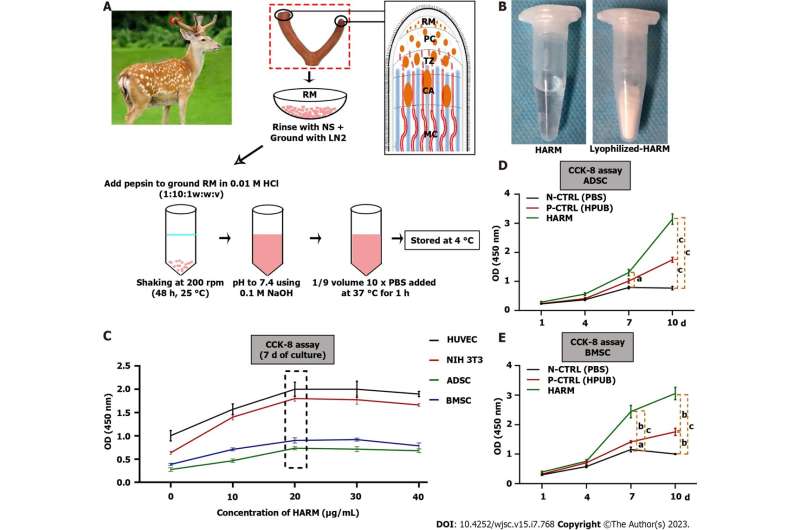This article has been reviewed according to Science X's editorial process and policies. Editors have highlighted the following attributes while ensuring the content's credibility:
fact-checked
proofread
Injectable hydrogel made from antler mesenchyme matrix for regenerative wound healing

Scar formation and loss of cutaneous appendages are the greatest challenges in cutaneous wound healing. Previous studies have indicated that antler reserve mesenchyme (RM) cells and their conditioned medium improved regenerative wound healing with partial recovery of cutaneous appendages.
A research team set out to develop hydrogels from the antler RM matrix (HARM) and evaluate the effect on wound healing. They prepared the hydrogels from the HARM via enzymatic solubilization with pepsin. Then they investigated the therapeutic effects of HARM on a full-thickness cutaneous wound healing rat model using both local injections surrounding the wound and topical wound application.
The research is published in the World Journal of Stem Cells.
The results showed that HARM accelerated wound healing rate and reduced scar formation. Also, HARM stimulated the regeneration of cutaneous appendages and blood vessels, and reduced collagen fiber aggregation. Further study showed that these functions might be achieved via creating a fetal-like niche at the wound site.
The levels of fetal wound healing-related genes, including Collagen III and TGFβ3 treated with HARM were all increased, while the expression levels of Collagen I, TGFβ1, and Engrailed 1 were decreased in the healing. Moreover, the number of stem cells was increased in the fetal-like niche created by HARM, which may contribute to the regeneration of cutaneous appendages.
Overall, the team successfully developed an injectable hydrogel made from antler RM matrix for the regenerative repair of full-thickness cutaneous wounds. They uncovered the molecular mechanism of the hydrogels in promoting regenerative wound healing, and thus have paved the way for HARM to be developed for clinical use.
More information: Guo-Kun Zhang et al, Injectable hydrogel made from antler mesenchyme matrix for regenerative wound healing via creating a fetal-like niche, World Journal of Stem Cells (2023). DOI: 10.4252/wjsc.v15.i7.768




















